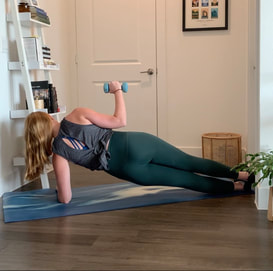|
By Dr. Katie Casto, PT, DPT  As we embark on a journey into the new year, many of us have goals we are setting out to reach- and many are related to health and fitness. As you may begin a new fitness journey in 2021 it’s important to keep in mind that setting up a plan as to HOW you will reach your goals is just as important as setting the goals themselves. For those fitness related goals, a crucial factor to include in your plan is recovery. Why is it important to prioritize recovery with your new fitness endeavors? “Overdoing it” without proper recovery (what many of us tend to do with our New Year’s resolutions) can be problematic. Without taking steps to prioritize recovery, we can experience a multitude of negative effects. Although it is important to include exercise at the appropriate intensity to challenge our bodies, it is just as important to give our bodies the TIME to adapt properly and recover fully in order to see the progress you want and stay on track toward reaching your goals without being sidelined by pain or an injury. How do you know if you are not taking enough time for recovery? One sign that we may be overdoing it is something we are all familiar with: muscle soreness. DOMS (delayed onset muscle soreness) refers to the soreness, associated muscle damage and local inflammation we experience typically 2-3 days after participating in a new type of activity, especially if it involves eccentric (working the muscle as it lengthens) strengthening (Hotfiel et al., 2018). In addition to the discomfort and localized muscular soreness associated with DOMS, it is associated with additional negative factors:
Soreness is not necessarily a sign of a “good” workout. It can be a sign of poor recovery especially if you are regularly sore or experience severe soreness, and can prevent you from being able to participate in physical activity for days after. It is one of the most common reasons for decreased muscle performance in sports (Heiss et al., 2018). How can you improve your recovery? Consider these 4 factors: Foam rolling Foam rolling can be a beneficial tool for enhancing recovery after a tough workout by increasing blood flow to the muscles.
Active recovery Another helpful way to boost your recovery is through active recovery! It can be beneficial to incorporate active movements rather than static stretching (long holds) into your cool down after your workout or on your recovery days.
Sleep An often forgotten but quite possibly the MOST important factor to consider with recovery (according to researchers) is sleep. There is a lot of evidence that supports the detrimental effects of not getting enough sleep:
Gradual progression of exercise It is crucial to have an exercise program that sets you up for success. It’s best to gradually increase exercise parameters rather than taking an all or nothing approach (which too many of us do with new year’s resolutions). Some things to keep in mind:
Unsure of how to set up a fitness or exercise program that works for you? Contact us- we’d love to help! We have plenty of options to best suite your needs and assist with your goals this New Year. References:
Akinci B, Zenginler Yazgan Y, Altinoluk T. The effectiveness of three different recovery methods on blood lactate, acute muscle performance, and delayed-onset muscle soreness: a randomized comparative study. J Sports Med Phys Fitness. 2020 Mar;60(3):345-354. doi: 10.23736/S0022-4707.19.10142-9. Epub 2019 Oct 28. PMID: 31684705. Pearcey GE, Bradbury-Squires DJ, Kawamoto JE, Drinkwater EJ, Behm DG, Button DC. Foam rolling for delayed-onset muscle soreness and recovery of dynamic performance measures. J Athl Train. 2015 Jan;50(1):5-13. doi: 10.4085/1062-6050-50.1.01. Epub 2014 Nov 21. PMID: 25415413; PMCID: PMC4299735. Milewski MD, Skaggs DL, Bishop GA, Pace JL, Ibrahim DA, Wren TA, Barzdukas A. Chronic lack of sleep is associated with increased sports injuries in adolescent athletes. J Pediatr Orthop. 2014 Mar;34(2):129-33. doi: 10.1097/BPO.0000000000000151. PMID: 25028798. Vitale KC, Owens R, Hopkins SR, Malhotra A. Sleep Hygiene for Optimizing Recovery in Athletes: Review and Recommendations. Int J Sports Med. 2019 Aug;40(8):535-543. doi: 10.1055/a-0905-3103. Epub 2019 Jul 9. PMID: 31288293; PMCID: PMC6988893. Dupuy O, Douzi W, Theurot D, Bosquet L, Dugué B. An Evidence-Based Approach for Choosing Post-exercise Recovery Techniques to Reduce Markers of Muscle Damage, Soreness, Fatigue, and Inflammation: A Systematic Review With Meta-Analysis. Front Physiol. 2018 Apr 26;9:403. doi: 10.3389/fphys.2018.00403. PMID: 29755363; PMCID: PMC5932411. Hotfiel T, Freiwald J, Hoppe MW, Lutter C, Forst R, Grim C, Bloch W, Hüttel M, Heiss R. Advances in Delayed-Onset Muscle Soreness (DOMS): Part I: Pathogenesis and Diagnostics. Sportverletz Sportschaden. 2018 Dec;32(4):243-250. English. doi: 10.1055/a-0753-1884. Epub 2018 Dec 11. PMID: 30537791. Heiss R, Hotfiel T, Kellermann M, May MS, Wuest W, Janka R, Nagel AM, Uder M, Hammon M. Effect of Compression Garments on the Development of Edema and Soreness in Delayed-Onset Muscle Soreness (DOMS). J Sports Sci Med. 2018 Aug 14;17(3):392-401. PMID: 30116112; PMCID: PMC6090402. Hody S, Croisier JL, Bury T, Rogister B, Leprince P. Eccentric Muscle Contractions: Risks and Benefits. Front Physiol. 2019 May 3;10:536. doi: 10.3389/fphys.2019.00536. PMID: 31130877; PMCID: PMC6510035 Comments are closed.
|
Meet Your TherapistJessica has been in Austin, TX for the past four years. She grew up in Idaho and attended PT school at Idaho State University. She completed an Orthopaedic Residency and became a Board Certified Orthopaedic Clinical Specialist in 2016. Archives
February 2022
Categories
All
|

 RSS Feed
RSS Feed